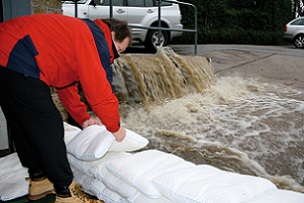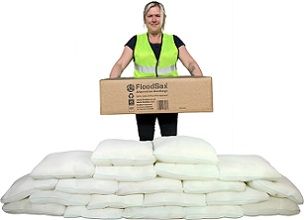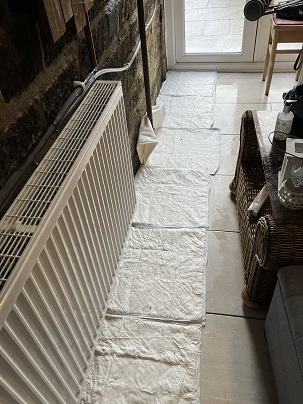 FloodSax original alternative sandbags are strong enough to hold back torrential floodwater
FloodSax original alternative sandbags are strong enough to hold back torrential floodwater
 All these 20 FloodSax sandless sandbags came from this one easy-to-carry box
All these 20 FloodSax sandless sandbags came from this one easy-to-carry box
 FloodSax are great at soaking up escapes of water inside homes and businesses
FloodSax are great at soaking up escapes of water inside homes and businesses
All major organisations in the UK now use FloodSax alternative sandbags
Almost every major organisation in the UK now uses FloodSax alternative sandbags to prevent flooding and soak up internal escapes of water.
The move away from traditional sandbags is gathering pace with more people realising they are environmentally unfriendly, largely ineffective against floodwater and can quickly fall apart.
FloodSax are tough, incredibly flexible and multi-purpose so can be used both outside and indoors – outside to stop floodwater getting in and inside to soak up leaks, spills and internal floods.
Organisations that now have FloodSax include facilities management companies, utility companies, local councils (to protect their own properties such as libraries and also to give to local ratepayers at risk of flooding), hospitals, health centres, supermarkets, schools, universities, care homes, nurseries, sports centres, London Underground, railways, drainage companies, water companies, waste recycling plants, sewage works, petro chemical industry, high profile sporting events, airports, fire services, car parks, stadiums, stately homes, storage units, highways, the plumbing trade, charities, flood action groups, countless businesses and thousands of homes.
FloodSax are the original alternative sandbag devised more than 15 years ago by Yorkshire company Environmental Defence Systems Ltd and since then almost 3 million have been sold worldwide.
Lucy Bailey from EDS said: “The number and span of organisations now using FloodSax is constantly growing as more realise that sandbags are a one-dimensional product which are supposed to keep floodwater at bay but, as anyone who has used them knows, they are largely ineffective.
“They are time-consuming to fill, heavy and difficult to shift anywhere and often quickly deteriorate when they come into contact with water, spilling sand everywhere, clogging up drains and causing even more environmental problems.”
FloodSax are known as the sandless sandbag or the instant sandbag as they are vacuum-packed in their dry state so are space-saving and easy to store. They resemble an extra large pillowcase in their dry state and the gelling polymer inside means they can soak up water leaks, spills, drips and internal floods and the FloodSax holds the water within it.
FloodSax are very thin with a large surface area which means they can be used in the most inaccessible places such as beneath boilers, underneath sinks and even below floorboards.
To transform them into alternative sandbags in around five minutes, fully immerse the FloodSax in water and the gelling polymer absorbs it and retains it to expand to become a sandless sandbag.
Lucy said: “The versatility of FloodSax means they can give instant flood protection inside and out 24 hours a day, seven days a week and have so many uses unlike traditional sandbags which have only one use … and they’re not very good at that.
“FloodSax are so much more cost-effective in that they can prevent thousands of pounds in flood damage. Just a couple of inches of water getting into a home or business can rack up huge repair bills and even force people out of their homes for months. When it comes to flooding, prevention is all-important.
“Sadly, people often only think about flood prevention once they’ve been flooded and suffered the heartache, misery and cost it causes.”
A box of 20 FloodSax is enough to protect most modern homes and retail at around £140 which is even cheaper than pre-filled sandbags.
FloodSax can be used by anyone as every home is at risk from escapes of water and more than 5 million properties across the UK are now at risk of flooding from outside.
According to the Association of British Insurers, £1.8m is paid out every DAY for water damage claims in the UK. Water wrecks everything it touches – floors, carpets, electrics, woodwork, plasterboard - which is why the average flooding claim for a house is £30,000 and a business is just over £70,000.
According to the Government, around 5.2 million properties in England - or one in six properties - are at risk of flooding. More than 5 million people live and work in 2.4 million properties that are at risk of flooding from rivers or the sea and one million are also at risk of surface water flooding.
For more information on FloodSax go to www.floodsax.co.uk